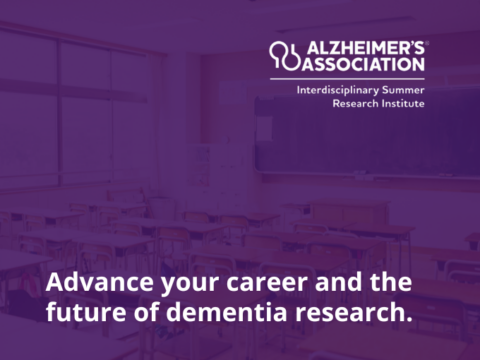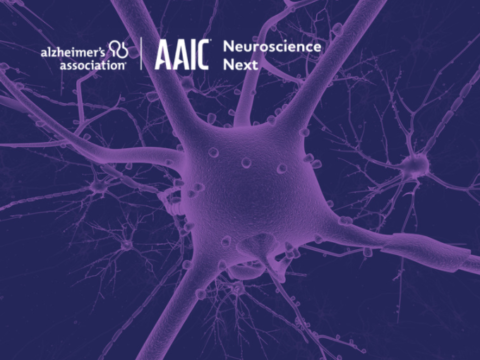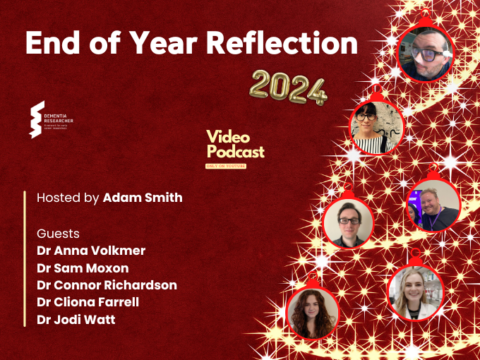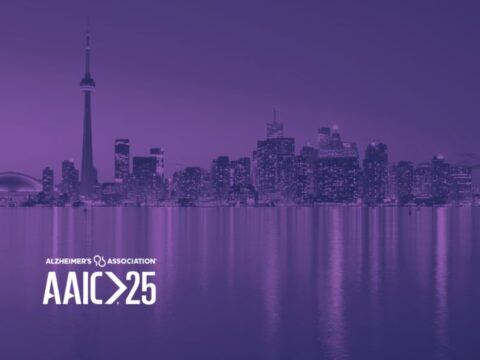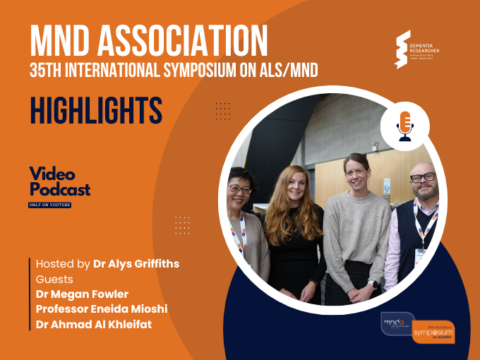Coverage from the Alzheimer’s Association International Conference (AAIC) bringing together early career researchers to share their conference highlights.
In the last of this weeks special shows, Dr Natasha Clarke from Centre de recherche de l’Institut universitaire de gériatrie de Montréal chairs the discussion with Dr Richard Lofthouse from University of Aberdeen, Dr Diana Karamacoska from Western Sydney University and Anqesha Murray, at Rensselaer Polytechnic Institute, New York.
Sharing highlights from the third day of the world’s largest dementia conference.
Follow the conference live at #AAIC22
Voice Over:
Welcome to the NIHR Dementia Researcher Podcast, brought to you by Dementia Researcher.NIHR.ac.uk, in association with Alzheimer’s research UK and Alzheimer’s Society, supporting early career dementia researchers across the world.
Dr Natasha Clarke:
Hello, welcome to the Dementia Researcher Podcast, on location from the Alzheimer’s Association International Conference in sunny San Diego. I’m Dr. Natasha Clarke and I will be your host for the last of these special recordings, sharing our conference highlights with three fantastic early career researchers. Today, we’re going to cover the fourth day of the conference, but before we start, let’s make some introductions. For those who don’t know me, I’m a postdoc SIMEXP Lab at the Institut Universitaire de Geriatrie de Montreal, where I research functional connectivity as a biomarker in Alzheimer’s disease and other disorders, as well as work on my French accent. My background is in psychology and machine learning, and so let’s move on to a brilliant guest. I’m delighted to introduce Dr. Diana Karamacoska, Anqesha Murray and Dr. Richard Lofthouse. Hi everyone.
Dr Diana Karamacoska:
Hi.
Dr Natasha Clarke:
Diana, tell us about yourself.
Dr Diana Karamacoska:
Hello, hello. I’m Diana Karamacoska from Western Sydney University in Australia. I’m also a postdoc. I’m actually the first person in my family to go to university, so it’s a huge achievement for the Karamacoskas, and I am a cognitive neuroscientist by trade. That’s what I did my PhD studies in, and now my postdoc work focuses more on public health initiatives to raise awareness about dementia and how to look after your brain as you get older.
Dr Natasha Clarke:
Fantastic. Anqesha, how about you?
Anqesha Murray:
Hi, my name’s Anqesha Murray. I’m a third year PhD student in biology at Rensselaer Polytechnic Institute. My background is in microbiology and immunology, but I actually joined a biophysics biochemistry lab. Not quite sure how that happened, but I’m looking at protein-protein interactions in Alzheimer’s disease, and neuroinflammation.
Dr Natasha Clarke:
Cool. And I think you also have a role in ISTAART?
Anqesha Murray:
Yes, I am also the communications chair for the ISTAART PIA to Elevate Early Career Researchers.
Dr Natasha Clarke:
Awesome. Richard? Last but not least?
Dr Richard Lofthouse:
Sure. Hi, I’m Richie Lofthouse. I just finished my PhD up in the University of Aberdeen in Scotland. I’m researching biomarkers, specifically looking at Tau protein, and I’ve escaped the cold Northeast of Scotland to come to sunny San Diego for the week. Really enjoying it. So far, it’s been amazing.
Dr Natasha Clarke:
Fantastic. We were saying earlier, we’ve got a nice array of accents around the table today. As we recall, this is almost the end of day on Wednesday and we’ve only got tomorrow morning left to go, so are you all sticking around until then? Are you conferenced out? It’s been quite an intense week.
Anqesha Murray:
Yes, it has been very eventful though. I’m leaving tomorrow at about 1:00, after checking out some museums and listening to a few of the sessions online.
Dr Natasha Clarke:
Sounds good.
Dr Richard Lofthouse:
Yeah. I’ve been here, I came from the pre-conference as well, so I’ve been here, it’ll be eight days in total, so it’s been a total whirlwind, but going to stick around for tomorrow as well, and then as Anqesha said, check out some of the museums and then head on home.
Dr Diana Karamacoska:
Yeah, likewise with Richard and Anqesha here. I’ll be leaving on Friday and I’m sticking around for a session tomorrow, looking at patient and public involvement in research. That’ll be really exciting.
Dr Natasha Clarke:
Interesting. Yeah, I’m really excited for the session tomorrow on psychosis and neurology, but like Anqesha, you were saying, I’m also going to look back at some of the talks online, I think next week once I’ve caught up on sleep a bit. Actually, it’s really cool that we have access to those. And have any of you been presenting today, or at the confidence, and how did that go?
Anqesha Murray:
Do you want to go first, Diana?
Dr Diana Karamacoska:
Oh yeah, sure, thank you. I presented a poster just the other day, and I was presenting on some work we’ve been doing with local governments in Western Sydney, looking at the challenges and opportunities that they face in designing supportive and physically enabling environments for people with dementia. I don’t know how into detail you want me to go with this, but-
Dr Natasha Clarke:
What are some of these challenges? Yeah, that sounds fascinating.
Dr Diana Karamacoska:
Yeah, absolutely. At this stage, we don’t really have any state level policies that encourage designs for dementia. That refers to being conscious of what kind of cognitive or sensory issues can impact people’s functioning mobility and their engagement with their environments. Because of that, we’ve got a lack of action happening at the local level, in our cities, and so I’ve come in to address those issues. We’ve got a lot of people who are interested in finding out how they can better support and plan for the amount of people that live with dementia in the region. What we’ve heard from our workshop participants is that they need more education and training on what kind of resources, what kind of actions need to be put into place. They lack collaborating with the universities on that kind of information and services, and they really need the academic institutions to advocate to the state governments or federal governments to actually put into action or place these policies that are going to support them.
Dr Natasha Clarke:
Wow. And so, what’s the next step for that piece of work, do you think?
Dr Diana Karamacoska:
Great question. We are already talking about setting up an education program that’s going to touch on all levels of government and community, including businesses. Any touch point for people with dementia, we are trying to encourage people to be more aware and be more inclusive of people with dementia, their needs, as well as their careers and families, who may find it hard to go out and about with them.
Dr Natasha Clarke:
It sounds a bit like… There’s something in the UK called the Dementia Friends Program. I don’t know if you’ve heard of that, where-
Dr Diana Karamacoska:
We have it.
Dr Natasha Clarke:
Oh, brilliant. Okay, yeah.
Dr Diana Karamacoska:
Yeah, we are basing our education initiatives on the Dementia Friends Program, and we are delivering it in multiple languages. We’re going to be touching on a lot of English and non-English speaking communities, who are quite disadvantaged in our area.
Dr Natasha Clarke:
But yeah, that’s particularly impressive, because I went to a few sessions today on cross-cultural limitations and language particularly being a real issue. Yeah, that’s [inaudible 00:06:52]-
Dr Diana Karamacoska:
Yeah, absolutely. Just on that as well, I did see a lot of posters, not enough sessions, I’m going to put this out there, a lot of posters talking about recruitment challenges, but also strategies to boost recruitment with minoritized populations or people from diverse backgrounds, and it’s so fantastic to see the incredible work that’s being done on the ground to foster those relationships.
Dr Natasha Clarke:
Maybe next year we’ll see some more talks on those as well.
Dr Diana Karamacoska:
Yeah.
Dr Natasha Clarke:
That would be great. And Anqesha, how was your poster?
Anqesha Murray:
Yeah, I also presented a poster on my project, titled A Structural Basis in Mechanism of Cyclophilin A, Tau Interactions and Alzheimer’s Disease and Neuroinflammation, and it was great to present. It was definitely good practice for me, being that I’m just now entering my third year of my PhD studies and being able to talk about my project and communicate it with people that have come from diverse educational backgrounds, so some are more familiar with neuroinflammation and some, I really had to break it down, which was a good exercise for me. I think being on the floor and seeing other posters were useful as well, because the talks are great, but they’re 10 minutes and it’s a lot of information in that 10 minutes, so I’m very happy they’re recorded, but with the posters, you’re able to just walk around and talk to the people that have their posters up and ask questions, just one-on-one, and it was a nice learning experience.
Dr Natasha Clarke:
That’s so true. I think I get some of the best interactions from people at their posters, actually being able to really ask in depth questions and understand. Yeah, that’s really great. And how about you, Richard?
Dr Richard Lofthouse:
I wasn’t actually presenting this week. This is my first big, international conference, so I’ve just been here to soak it all up and experience it. It’s been, as I said before, just an absolute whirlwind. Took a few days to get used to, but I think, so I’m a bench scientist by trade, so my favorite thing throughout the conference has been speaking to people who are patient facing. As a bench scientist, it’s really easy to, you sit there, and you have a group of plasma samples. They’re all numbered. You know nothing about the people who have provided these samples, which we’re so grateful for, but to see and discuss with people who are at the forefront of the patient interaction thing, it really reframes why this work is so important, and that’s been absolutely one of the best things about it so far, definitely.
Dr Diana Karamacoska:
Totally. Yeah, I love the connections between the different disciplines. You really get to see what’s happening from bench to the real-world application-
Dr Natasha Clarke:
Bench to bedside, yeah, for sure.
Dr Diana Karamacoska:
Yeah.
Dr Natasha Clarke:
Yeah, Fantastic. Okay, next order of business; for those who are new to the format of these shows, we really just go around and talk about our best bits of the day. As I’m hosting, I’ll share one of mine first. I attended the Ask Q and A today, with Margot Kushel and Francisco Lapera, who both presented fantastic plenaries yesterday, but I really like these Ask sessions, because I think you just get a much more intimate exposure to people’s research, and some of the questions that come up are really fascinating. But today someone asked about careers advice, and I really loved Dr. Kushel’s answer. I thought I’d just share that, which was that ECR should try and work on what keeps them up at night, so the problems that they’re concerned about. And she said that was because days are long and research is hard, so you need that motivation, but also, if you are concerned about it, it’s probably important. And even if other people haven’t thought of it or they might not necessarily agree with you, the fact that you think it is means that you should try and work on that.
Dr Diana Karamacoska:
That’s wonderful advice.
Dr Natasha Clarke:
I thought so, yeah. I thought I’d just share that nugget. What’s been everyone’s highlights today? Diana, should we start with you?
Dr Diana Karamacoska:
Sure. I was at the Popup Academy, which is a workshop that we host for early career researchers, and also graduate students. We had a session on career transitions, and it was set up in a really cool way. We had one table that was looking at transitioning between institutions, particularly when you are traveling across countries, and we had another table looking at the transition between academia and industry, and then the third table was talking about the art of negotiation, so when you’re transitioning between those pay scales, it was fascinating. I particularly like the art of negotiation, because I feel like I’ve learned a lot of insider secrets.
Dr Natasha Clarke:
That is not usually something that we are taught about in academia, so I think that’s really great.
Dr Diana Karamacoska:
Absolutely.
Anqesha Murray:
Especially teaching women the art of negotiation, and to be confident enough to really vouch for themselves and make those arguments and understand their value and worth that they’ll bring to the company.
Dr Diana Karamacoska:
Absolutely, yeah. And we really had that from the two mentors who were at this table. One of them was explaining how she felt really nervous and to the point where she felt sick, asking for what she was asking, and the other one had a different experience. She recognized her value and her contribution to that particular institution, so she was able to argue… Both of them argued very well to get what they deserved and were after, but it was fascinating to hear about how they had to navigate that system.
Dr Natasha Clarke:
Yeah, and serendipitously, myself and Anqesha were also at that event today, and one of the things I really took away from that was that it’s not necessarily a case of leaving academia for industry anymore, because that’s something you hear a lot. You see people on Twitter announcing that they’re leaving academia and things, but actually we were talking about the fact that you can more easily go between the two, you can go to industry, you can come back to academia, and you will always take different skills from both that will make you valuable in both of those capacities. That was really, really great to talk about.
Anqesha Murray:
Yeah, and that’s not something I think I realized you could do. I always thought once you left academia for industry, you just stayed in that workspace, and you wouldn’t necessarily go back, or even want to go back. But to know that her experience in particular was very fluid, and she was able to take the skills she learned in industry and bring it back to academia, have a different mindset when it was talking about attacking a project or even her mentoring strategy, it was very interesting to hear.
Dr Diana Karamacoska:
That is really great. I think we have a different take on it in Australia. We tend to hear that once you leave academia, coming back is just not an option, but I’m sure we’ll catch up.
Dr Natasha Clarke:
Richard, what was your highlight from today?
Dr Richard Lofthouse:
Well, just that conversation you were having there. I sort of alluded to my highlight before, in the previous conversation, but I was just thinking there, how many inspirational women leading sessions as role models for have been… I don’t want to comment too much as a male, but from the outside looking in, there’s been some amazing talks that even I have found really inspiring, and just the number of younger, female ECRs I’ve seen giving amazing talks, rocking it at the posters, has been a highlight that just popped into my mind just there. It’s been really, really great.
Dr Natasha Clarke:
I’ve really noticed that as well, and think, yeah, comment on it as a man, definitely. There’s no reason that you shouldn’t.
Dr Richard Lofthouse:
It’s one of those things you never… You don’t know if you should comment or not, but no, represent, definitely.
Dr Diana Karamacoska:
No, lift us up. We need it. We want to.
Anqesha Murray:
Absolutely.
Dr Natasha Clarke:
Yeah, I’ve noticed, I’ve been in quite a few talks that are… I don’t know if people have heard the term manel, like a panel made up of all men, which used to be the norm, and I’ve seen a lot of the opposite of manels, a fanel, I don’t Know. But yeah, any other highlights? Any talks?
Dr Richard Lofthouse:
I went to a session today. There’s been so much great biomarker research on show at the conference that I’ve been biomarkered out almost. I’ve been trying to diversify and go to some other talks. There’s one really interesting one, looking at polygenic risk scores for Alzheimer’s disease, so rather than the key risk factors, so age or genetics, such as APOE, looking at combined risk factors of other smaller things that accumulate together to make a risk score on their own, and there’s some amazing work going on in that. And combining that with the biomarker research that is going along onside, and they seem to be really synergistic. Again, just looking, its interdisciplinary combinations have been really good. Also, one just there on TBI, so traumatic brain injury. As an ex-rugby player, it’s something that has been eye-opening, certainly. That was something I found really interesting too.
Dr Natasha Clarke:
Yeah, fantastic. Yeah, I think there’s been a lot of more collaborative research-
Dr Richard Lofthouse:
Exactly. That’s the word I was looking for.
Dr Natasha Clarke:
… that you can see whole sessions on new imaging and genetics, which is really, really interesting.
Dr Diana Karamacoska:
I love that we’re moving towards this in dementia research. I’ve seen a lot of stuff on precision medicine and really looking at the individual and how we can tailor medicines or therapeutics or interventions to meet their needs.
Dr Natasha Clarke:
Mm-hmm, yeah, for sure. Anqesha, what’s been your highlights?
Anqesha Murray:
I think my highlight had to actually be the student and postdoc workshops. Yesterday, I had the pleasure of leading the How to Run an Eco-Friendly Lab Workshop, and that was a great experience, and then returning today for Diana’s session that she led was great, because being at the industry table, I feel like it’s great to have the conversation. Sometimes an institution, your PI, or other leaders in the lab may not want to talk to you about industry or ‘alternative careers’. Being in a safe space to openly talk about it and just discuss the differences, what can potentially be the pro, what can potentially be a con, was very insightful.
Anqesha Murray:
And also, there was a few sessions that I attended online that I was able to listen to, and although they’re 10-minute sessions and it’s very hard to follow all of it, as an early career researcher and being new in the lab, it did open my mind up to certain avenues I can start looking into, specifically for Tau-mediated pathologies, and then they also had one that altered glial function, and it was very insightful to see, okay, maybe I can move my project in this direction or use this new technique to do imaging and to look at a neuroinflammation. Just all in all, the sessions for today were pretty great.
Dr Natasha Clarke:
Awesome. And just because I saw in the program about the eco-friendly lab, and could you just say a bit more about what that really means?
Anqesha Murray:
Yeah, absolutely. Actually, I’m not a climate change expert enough that in… To my presentation at the beginning, don’t go back to your lab and say, “This is all Anqesha said I needed to do to be up to date.” And I don’t have all the answers, but it was a very diverse group in terms of the knowledge that we were bringing to it. And one thing that was brought up, running the eco-friendly lab, the context of it basically was, what can we do in order to minimize plastic waste, conserve energy, and reduce water use? Those were the key things, and then in doing so, how can we hold labs responsible to maintain this and be consistent and be transparent? What systems can we put in place to help labs that maybe are more progressed in being eco-friendly or have a climate change action plan, versus other institutions that are further behind, or maybe don’t have the funding to necessarily upgrade all of their systems.
Anqesha Murray:
It was an insightful session, and one difference that was brought up that I didn’t previously think about, is the fact that I work in a wet lab. What it may look like for me to be more eco-friendly is very easy. Maybe order from different suppliers that have sustainable packaging or making sure the faucet is turned off. Can we reuse that plastic tip box every time we need tips again? But then other people in the group, they were in more… It was exercise imaging. If you’re listening to this, I hope I didn’t say that wrong, and they were like, “I’m not sure what we can do to be more eco-friendly, because we use the same equipment, we sterilize it and that’s it, so how could we necessarily play a part in this movement?” But one thing they did mention was that the labs upstairs from them are wet labs. Bringing what they learned from the session back to those labs and seeing if they can educate them and potentially get them in a program to run a more sustainable, eco-friendly lab.
Dr Natasha Clarke:
That’s fascinating. And my field is more computer science, and I know there’s a lot of concern and discussion about the impact of that on the environment, in terms of energy consumption for deep learning models and things like that, and so I didn’t know that wet labs had their own issues, and sounds like solutions as well, that people are coming up with.
Anqesha Murray:
Yeah, and that was definitely something I didn’t think about, just coming from a wet lab background. I’m like, “I throw away a lot of tips every day. I use a lot of gloves every day.”
Anqesha Murray:
And they were like, “What do you mean? That sounds great that you’re doing that, but we’re not sure how we can help.” And that was another question, is if you are in a computational lab, is there really anything you can do to minimize that energy use? Maybe not, because you need it to graduate. It was just a lot of questions that were left unanswered, but at least we got the conversation started, which was great.
Dr Natasha Clarke:
It’s definitely something I need to learn more about, that I’m interested in.
Dr Diana Karamacoska:
You could follow up on that at next year’s conference.
Anqesha Murray:
This is true. That’s a good idea.
Dr Natasha Clarke:
Yeah. I think that one of the things that struck me about AIC this year, I don’t know if you’ve all been before, but there have been so many great sessions outside of the talks and the plenaries. Obviously, they’re fantastic, but the careers advice, these kind of workshops and things, really valuable for ECRs in particular.
Dr Richard Lofthouse:
Yeah. Just networking in general has been amazing. I’m the only person from my lab here, so I came, first AAC, not knowing anybody at all. I’ve made so many new connections. I’ve got so many new ideas and potential collaborations already off the back.
Dr Natasha Clarke:
That’s great. Do you have any tips for anyone else? Because it’s quite intimidating coming to… It’s a huge conference for people that haven’t been here, and it can be quite intimidating knowing how to meet people and network and things.
Dr Richard Lofthouse:
Yeah, certainly even I was… It’s scary putting yourself out there, but I think just go for it would be my number one tip. If you’ve followed someone, so I’ve been speaking to people who I’ve cited multiple times in my thesis that I wrote, and it’s a really easy icebreaker to be, “Oh I cited your umpteen times in my thesis.” Nobody’s going to be sad that you’ve done that, so that’s a really great icebreaker, but check all the abstracts go out beforehand, so you can look through and find where people’s posters are going to be. You have to just go for it, would be my advice. It’s scary, but every time you do it, it gets easier.
Anqesha Murray:
Yeah. And I’m in the same boat. This is my first conference, or AIC conference I should say, and I came here by myself. I learned a lot, being that it was my first ice break. One is, even with presenting a poster, I presented my poster and walking around to the other posters and hearing how they present theirs, I was like, “I really like that. I’m going to do that next year.” It was a good learning experience for things I can change, and also, I realized for the next time I attend the AIC conference, looking at those abstracts, as you mentioned, beforehand, so then when I’m here and I have a chance to talk to these people, I have a game plan and I already have that conversation starter. And also, there’s a lot of events that goes on in one day, and I didn’t realize that maybe the night before, I should plan out the day, so I know I’m making it to everything I want to make it to.
Dr Natasha Clarke:
Yeah. I felt like Sunday, which was the first day, it was my first in-person conference since COVID, which in itself was quite strange, and I’d forgotten how you do it. I just didn’t plan, and I wandered around and I felt really overwhelmed and things. And then Monday I was like, “Okay, I need a plan.” And it was much more fruitful. We’ve covered some of this, but does anyone have any other highlights from the whole conference that they wanted to share?
Dr Diana Karamacoska:
Oh yeah. This is so off topic, but I got really excited about the 3D printing that was happening around the coffee machines.
Dr Natasha Clarke:
Oh my gosh, me too.
Dr Diana Karamacoska:
Can we just address the fact that we have pharmaceutical companies who’ve come up with these amazing advertising techniques to really pull people in? You go in, you order your coffee, and you can get your picture or photo 3D printed onto your coffee. I got my dog, but it’s such a good way to strike up conversations, even with people who were in the line. Yeah, just-
Dr Richard Lofthouse:
The technology life science didn’t know it needed, right?
Dr Diana Karamacoska:
Yeah, exactly.
Dr Natasha Clarke:
I got Ada Lovelace printed on mine, who, for the people who don’t know, was the first woman to invent the computer program.
Dr Diana Karamacoska:
Nice.
Dr Natasha Clarke:
Any other highlights anyone wanted to mention?
Anqesha Murray:
The receptions have been nice.
Dr Diana Karamacoska:
Oh, there’s been so much dancing.
Anqesha Murray:
Yeah, so much dancing and socializing, and I consider myself to be an introvert and a naturally shy person, and just being in a let loose and build on the connections you made earlier in the day was really nice.
Dr Natasha Clarke:
There’s nothing quite like seeing a very important professor dancing, to really break the ice, I think.
Dr Diana Karamacoska:
Yeah, absolutely. I think, as well, it’s been so refreshing or, I don’t know, exciting just to be face-to-face with people that you’ve been working with online for the last two, three years. It completely changes the nature of the relationship. You do become more like friends. I would consider us all friends after that experience, but yeah, it’s very different to when you are sitting behind a screen.
Dr Richard Lofthouse:
Yeah. There’s so much interaction and networking that happens out with the sessions, whilst the sessions are really great and really important, I think I’ve learned more in discussions out with those sessions. And yeah, another highlight has just been how great everyone has been. You come to this, you’re not really sure what to expect, but I think we’re all… Especially in this industry, we’re all kindred spirits to a certain degree. We’re all working towards the same goal. And yeah, everyone’s just been… The whole vibe of the whole week’s been really great.
Dr Natasha Clarke:
Great. And we’ve got a little bit of time left, so we’ll just do maybe our one takeaway for your research, or something you think you’ll remember when you go back and you’re working on your projects and things. I think one thing for me, there’s been so many, but really, the importance of looking at sex differences. And that’s been quite strong this year, which is fantastic to see, because it’s something that we’ve been talking about for a while, but there’s a whole session on it today. There’s been various talks, lots of posters, so thinking more about the importance of studying men and women in Alzheimer’s disease, and why we might be seeing those differences there, so different mechanisms, and not just assuming that those differences don’t matter. I’m definitely going to be paying more attention to that in my research.
Dr Diana Karamacoska:
Absolutely. Yeah, that’s something we are very conscious of as well in the laboratories that I’m part of, with the neuroscience studies that we run. Adding to that, I would say we really need to think more inclusively about how we’re researching with our participants, what demographics we’re missing from our data sets, how we can include them, how we can better research with them, but also within our teams, you need to have that diversity in order to promote that kind of research on the ground.
Dr Richard Lofthouse:
Yeah, I think I’m just going to echo exactly that again, and more from the scientific standpoint as well. There’s been a real emphasis this week on increasing diversity within sample groups for looking at biomarkers, for example. I think current studies are very much weighted towards older, white people, who maybe have the time that they’re not… They have the time and the availability to go to give a blood sample or whatever, and other people may struggle. They don’t have the time to do so or it’s not an environment that they’re aware of.
Dr Richard Lofthouse:
Increasing awareness and increasing the diversity of these groups is really important. And alongside that, I work with bits of kit that are really expensive and hard to get ahold of, so improving access to these bits of kit in lower middle-income countries, but then also thinking, biomarker research, a lot of our samples get stored at minus 80 degrees. Whilst we have lots of minus 80 freezers in our lab, other labs may struggle to get this sort of thing, so thinking about ways to diversify the methodologies needed that is going to work to improve the research in countries with less access.
Dr Natasha Clarke:
Yeah, that’s so important. And on the diversity in participant samples as well, I’ve had some really great conversations with machine learning people here, because that’s really important for those, when we’re training algorithms, are they actually going to tell us about the more general population if we’re only training them on a very narrow sample of people? That’s a discussion that’s quite hot in those areas, so it’s great to see that that’s really being-
Dr Richard Lofthouse:
That’s something that my eyes have been open this week, definitely. It’s been really good.
Dr Natasha Clarke:
Yeah, brilliant. And Anqesha, what will you be taking back with you, or thinking about?
Anqesha Murray:
Yeah, I think one big thing for me was the benefit of collaboration. And I think as a student, you may get tunnel vision and feel like you need to do everything on your own, and I’ve noticed here through the talks that a lot of scientists collaborate, and it brings something new to the story that they’re telling when educating people about their research. It gave me a few ideas of how I can collaborate with other scientists, even within my lab, and how that can benefit me and benefit my research. That’s definitely something that was a big takeaway for me.
Dr Natasha Clarke:
That’s a great takeaway.
Dr Diana Karamacoska:
I’ll do a quick summary as to what I’m hearing here. Invest in your people.
Dr Natasha Clarke:
Love it.
Dr Diana Karamacoska:
The teams, your participants, communities, that’s where we’re at right now.
Dr Natasha Clarke:
Yeah. Okay, that’s all we’ve got time for today, unfortunately. As ever, you can find Twitter links and bios for today’s guests on the Dementia Researcher website, at dementiaresearcher.NIHR.ac.uk. It’s time to end today’s podcast recording. I’d like to thank our guests, Diana, Anqesha and Richard, thank you so much. I’d also like to thank all of you for tuning into these special podcasts this week. Remember, you’ll also find a massive amount of information on social media, using the hashtag AAIC22. Thank you all for listening and thanks again to our wonderful guests.
Dr Diana Karamacoska:
Thanks for having us.
Dr Richard Lofthouse:
Thank you. That was great.
Anqesha Murray:
Thanks for having us.
Voice Over:
Brought to you by Dementiaresearcher.NIHR.ac.uk., in association with Alzheimer’s Research UK and Alzheimer’s Society, supporting early career dementia researchers across the world.
END
Like what you hear? Please review, like, and share our podcast – and don’t forget to subscribe to ensure you never miss an episode.
If you would like to share your own experiences or discuss your research in a blog or on a podcast, drop us a line to adam.smith@nihr.ac.uk or find us on twitter @dem_researcher
You can find our podcast on iTunes, SoundCloud and Spotify (and most podcast apps) – our narrated blogs are now also available as a podcast.
This podcast is brought to you in association with Alzheimer’s Association, Alzheimer’s Research UK and Alzheimer’s Society, who we thank for their ongoing support.
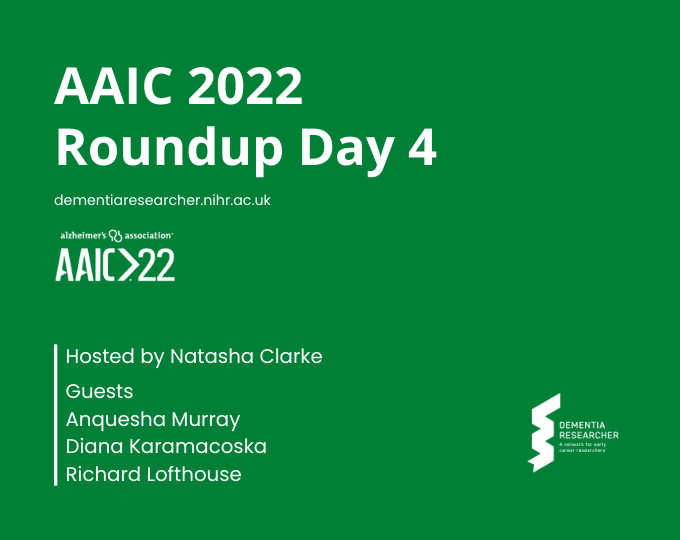

 Print This Post
Print This Post
